Execution of the passing game:
This is the section everyone is curious about. How do I make this work? There are a couple simple keys. First of course, is protection. This is where it starts. Your high flying pass offense better not be laying on its back. There are a lot of debates on the setup of OL, but in this kind of O I like to protect the inside first. Therefore I usually delay both guards .2 and delay both tackles .0(I know it's 0 but thats what it says and it is a delay) before they pass block, and I do not delay the center any. If I have a back in the backfield he will line up next to the QB(as in this I usually will go with shotgun, but I do not like 8 or 9 yard shotguns. I have put my QBs under center before but the offensive line is still stupid and there are plenty of real life teams who go gun whenever they go spread.) The blocking back will delay .1 and then move at more or less a 45 degree angle in front of the QB and then will pass block. This is not the end all be all, and there are other things, and different types of blitzes and pass rushes can require adjustment, but this is the standard I usually go with, and as long as I'm smart with my passes I don't have much of a problem if any.
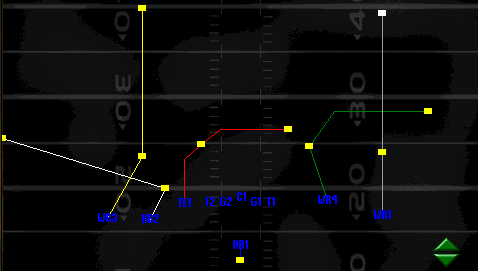

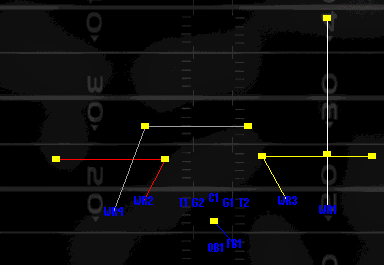
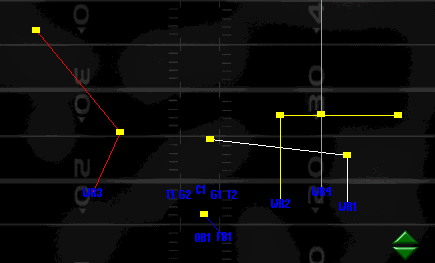
Finally, we come to the QB. The distributer. I'll get into later what I think makes a good QB, but for now I'll talk about what he should do in these plays. In this kind of offense, unless it's a rollout, he should not be doing much movement. On the quickest of passes, he should simply catch and pass. No movement logic, just put him in the gun a bit and he should have check receiver. In most of my no back passes and some of the others, but it's a case by case situation, I will have him check pass the various receivers in whatever order I choose, and then give him the smallest of backwards movement path. (Note: Make sure, even if he is in the shotgun, that he is aligned dead behind the center because otherwise, instead of doing a dropback, he will turn and run backwards and then try to turn back around and it will not only mess up the timing but will probably get you sacked.) It's pretty simple and stays pretty static. You can try moving the QB left or right, but I find most of that takes too long and I'm better off just having him stay pretty much where he is. And blocking often breaks down in weird ways when I do that. I mentioned rollouts, and I'll just address them here. I use rollouts a bit, but not that much, and while often they only have one back and such, I wouldn't really consider them part of the spread. So you'll have to do your own homework on that one, heh.
Running Game:
Now we're down to the nitty gritty here. However, I won't go crazy in depth, because I notice that it seems like most people spread the D out anyway when they run inside. And because I spread the D out so much and throw a lot in the flats and screens and whatnot teams are already sitting in the flats so sweeps aren't that beneficial to me. So I focus on inside runs. And I have most of the basic runs in my plan. But I use the shotgun in my passing game a lot, so it wouldn't be kosher to have no runs without the shotgun. So I'm in the shotgun, a lot of people put their HB 10 yards back. I didn't do that in my passes either. No one does that. So I have to figure out how to make plays that pre-snap look exactly like my passing plays that are effective runs. Not really a problem. I keep most of my run blocking schemes pretty simple, either using block push left, right, etc, fire out. I use a few block lead to's with my tackle's sometimes, with the path straight up field, and I use move to's with my OL also. Nothing that fancy. If you want to see more on the running game look at what Darrell Young wrote about the running game on the FBPro University. However, I'll show you how I handle my backs. I, unlike Darrell, like to give my athletes, in this case my HB, freedom to roam so I like to stop the run logic behind the LOS and give him run inside. (run to daylight usually results in him running around end into a wall of defenders) With this I have given my HB, who usually is one of the better players on my team(though not always) the ability to pick his hole. I cannot predict where the DL will line up, where the LBs and DBs will line up, if he is in man or zone or what. But with this I give my player the ability to choose. He isn't always right but he usually is, and I delay him at the snap before any move to's, and I give him a short move to and then the run inside logic so it should all time out and be fluid. However, if I don't have a RB with good AG and IN(both crucial to letting your HB choose) or just to mix it up, you may want to give the runner a move to path that extends far beyond the line of scrimmage. However, the RB is only lined up about 5 or 6 yards behind the line of scrimmage and right next to the QB. Where does he get his momentum? I sometimes will delay him and then have him run forward, but that isn't all that effective. More effective is something I learned from watching shotgun teams in real life run the ball. The runner will line up on the opposite side of the QB than the hole is. If you want to run off right guard line him up to the left. He will probably delay .0 to time it out, and run right in front of the QB, just getting past the QB he'll begin to turn upfield, and by the time he gets to his hole, probably just ouside the guard, he'll be heading vertical up field. Be careful not to give too many points on his movement path or he'll turn around and stop and generally act stupid. A plus to this is m2m and other defenders will often overrun the RB because he starts out running horizontally before turning vertical.
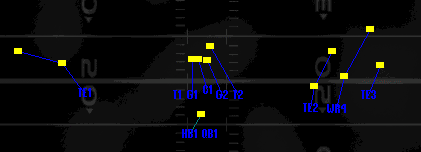
The last thing I'll talk about is something I use in spot duty, but I have a friend who uses this a lot and extremely effective. That is the QB draw. Especially if you have a great running QB, who maybe is otherwise sitting the bench, it can really wreak havoc. It can be stopped like any other run, by jamming up the middle, but by spreading the defense and allowing the QB to run is extremely effective versus defenses that don't put people in the middle. You mostly want your OL to fire out, either with that command or some push left or rights or move to's as normal. I then give my QB simply the run inside logic, he should have good IN being a QB, and let him pick his hole and go. Very simple. Very deadly.
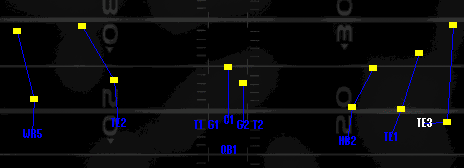
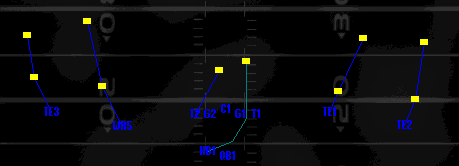
Personnel:
I mean it's pretty obvious without talent you aren't going to get anywhere doing anything, but you do need some fairly decent players to run this O. But that's like anything else. I mean you can't run the football with a nothing back and you can't do anything on offense with joke linemen. So like any other pass offense it helps to have a good QB and some good receivers. I can't give specific numbers for guys, because different leagues have different highs and lows. But you can always compare your guy to the other QBs in the league and pick the best QB on your roster. The most important rating I think for a QB is DI. DI is what controls accuracy and that is so vital. Especially in this offense where runs after the catch are so key. Nobody wants a QB who can't hit his target so that should be obvious. The next two ratings are pretty equal, and they are ST and IN. IN is more important in the spread than most offenses I think. Because your QB needs the ability to cycle through receivers and quickly go to the one who is open. This is hard to gauge, but finding the open guy is so very important. ST will effect deeper passes and passes to the sidelines, but will probably effect the rest of the passes more than the ones in the spread. But for the go routes and things it is vital. ST directly effects accuracy of any pass longer than a few yards. EN is important I feel like but it's your team. The athletic stats like SP, AC and AG are important if you want your QB doing things like the QB draw or rollouts. And it is important for QB drop speed. AG also effects quickness of release.
The great thing about the spread, is through shifting and motion, it doesn't matter who your best players are. If they are 4 or 5 WRs, a couple WRs and your HB and Fullback, if your TE is good. They all have a place in the spread running the pass routes and all are easily put in, just simply play with the shifting and shifting out of the backfield and you're in the same setup with different personnel. The key to any offense is getting the ball to playmakers. The spread just gives you another way of getting them the ball in space. In skill players I look for speed speed speed. Next is AC. AC is so crucial to cuts. From there just they should be well rounded. ST is very important for broken tackles, but most WRs and things don't get real high in that department. HA are important, but as long as it is above average you're doing fine. SP and AC is where offense starts.
The OL should obviously be able to pass block. ST is important but not as important as if you want to run it constantly. Next comes AG, as this controls how well your guys move to defenders. HA is important also as if all things are equal with ST and such the tiebreaker for who wins the battle is HA. From there, again good EN and whatever should just suit you. ST and AG are about equal and then after that a bit distant is HA.
You don't need world beaters to run the offense, but you should prepare knowing what you're going to do. Don't horde blocking fullbacks and tight ends and OLinemen with no AG if you plan to run this. But this works even if you only have a couple good receivers, maybe a halfway decent possesion tight end and a couple decent backs. All of a sudden you can get them the ball and they are making plays you didn't think they could make. And then say you draft or trade for some superior talent, all your things should work the same, you should just notice the yards per pass, completion percentage, yards per carry, passer rating, and hopefully total points, go up. It just improves what you're already doing.
Finally the question is "Alright now I've got my passes and runs, how do I use this?!" The runs should easily fit into your system, and the passing game should slide in easily also. Obviously, you probably aren't going to go 5 wides and then set that up as your long passing offense. I think the best way to use this, is to have your entire short passing game, and then maybe a small portion of your medium passing game as the spread. Since I started doing this, I could, using my profile, have my guys throw the ball short more often and get good yards and big play potential, and since I'm throwing short it hurts blitzing teams. Most of my long passing offense, which I use fairly sparingly, has a lot of blockers. The depth of my pass routes and the number of blockers should always be scalable. If I have only 5 or 6 total blockers, my passes better be short. If I'm using 7 guys, my routes get deeper, and even 8 blockers are usually my deepest passes. So the spread stuff fits in easily, and ends up crossing up the defense pretty well so they don't know how to handle me exactly. The key to offense is completions and moving the chains with consistant gains, and that is what this is designed to do. Therefore, if you install this as your short passing game, and you keep your good solid medium and long passes, or even incorporate some of these ideas into how you build those, along with your running game, you're then able to pick what you want to lean to based on you, and your personnel, and even your opponent. If you're a running coach, you are still able to have your running game, and then when the D is packed inside for your run game you pop out on 2nd and 6 and go spread on them and hit them for some quick yards or maybe someone even gets deep and scores. You can imagine how tough that would be. Or on the other side if you're a passing guy, suddenly besides guarding against you deep and your old basic stuff, suddenly you've found a way to get the ball all over the field to almost every area at a different time, so he has no idea where to put his reads or dot zones. And he has to keep 5 guys in m2m because you keep hitting the fullback or HB shifted out of the backfield for gains. You just hope the spread adds a dimension that is difficult to stop.
Another note is, please understand your league files. I've been in leagues where the defensive line and people were too fast to do hardly any of this. However, with the VPNFL files and more files like them it's more possible to do such things as they do in real life. So just keep that in mind as well.
However, the spread isn't always going to work always and that is something one will have to remember. Hopefully by running a mixed or varied offense it can stay effective no matter who you play because they can't key on it. But, you also must scout week to week and understand if the teams run certain things that will limit the spread or won't make them effective. Certain blitzes can hurt it, so with the rest of the offense you key on that. Certain coverages can hurt the short passing game, hopefully the go's or other deeper pass plays can hurt those. But if you experiment and try it, you'll find the spread can be very effective and should have many uses.
The key to finding your best plays is practicing. I suggest everyone gets a copy of WinLogStats as well. It is extremely effective. Here is the quick explanation of how I test to find the best plays. You should experiment and create roughly 30 unique spread passes. Give or take. Put them in a gameplan. They should all be listed as the same type of pass(short pass middle would work well.) Then, download the PPPs of some of the better teams in your leagues, the teams with the best defenses and are overall good. If you have closed PPPs, I dunno how to help you really. You can try using your own plays but that really isn't what you want since you won't be playing yourself during the season. You then create a new 8 team league, put every team as your team. Every single team. Yep, if your team is Buffalo, they should all be Buffalo. Ok you've got it. Now go into this league, and give every team the same offensive profile and your new gameplan of your spread passes. For the defense give each team a different defensive plan/profile for all the best teams in your league. True their plans won't match up personnel perfectly, but it'll work well enough. Now run an entire season by simulating each game. (Not fast sim! It should create a log and highlight for each play if you've got it set to highlight each play.) Oh I hope you had logging on. You can do that by starting the game with the flag -l. It should take roughly half an hour or so. Not that long. Depends on your computer speed though. When you're finished, load up your gameplan in the play editor and then load up win log stats. Hit new DB or New Database and load all 40 or so logs. You should have a pretty equal distribution of all the plays and a lot of hits for each one in different situations. Then just start eliminating out of your gameplan the ones that give up too many sacks, maybe eliminate the ones that give up too many INTs if for some reason it is steep. And then eliminate the ones that don't make the cut based on a combination of yards per pass and completion percentage. You should be able to narrow it down to 8-15 or so passes and they should be pretty good ones. You can even go fewer if you like. Another thing you can do is look why some worked so much more than others. In my opinion, nothing should work less than at least 60% completion percentage and shouldn't be less than about 8 yards per pass give or take some, and if you're only getting 8 yards, you should expect a pretty high completion percentage. If a play has 15 yards per pass and completes 40 percent. Dump it. If a play completes 80% for 4 yards a play, dump it. You get the idea.
Anyway, hope that helped. It's not always easy to pick your best plays. Once you've gotten those plays, and you can do that for your run game looking at yards per carry, or for defense or other passes. (The more yards a play gains each time the lower you should require the completion percentage to be.) Anyway, as I was saying, once you've gotten your base offense that has been narrowed down and should work vs just about anyone consistantly, you need only tweak it week to week. So you don't need to mess with all kinds of scouting time every week
One final note is, nothing against timing passes, a lot of good coaches use them, but I hate interceptions and as a general rule you'll throw a lot more with timing passes. That's why I don't use timing passes. Turnovers are lethal to offense. Absolutely lethal. There that's all.
Email me at doc@u.dal.net
I hope this was beneficial. Just to give you all insight into who I am, and what my credentials are for anyone to listen to me, my name is Chris Brown, a.k.a. Doc. I've won championships in the TFF, NSFL and two in NAFA. I've been runner up in the CBFBPL and in NAFA. This past year I took over PCFL Colorado(Now Kentucky) and I went 10-2 and was defeated in the semifinals. Here are some of the stats I've put up before.
Passing
-----------------------------------------------------------------
NAME ATT CMP CMP% YDS AVE/ATT TD INT RATE
Smelt 686 506 73.7 6308 9.2 76 4 137.7
Wolf Pack 686 506 73.7 6308 9.2 76 4 137.7
Receiving
Season
----------------------------------------
NAME NO YDS AVG LG TD
Cole 113 1607 14.2 73 16
Green 130 1502 11.5 35 16
Rice 99 1370 13.8 53 18
VanderPoel 71 1153 16.2 57 10
Francis 72 654 9.0 41 11
Benjamin 10 109 10.9 13 3
Sanders 3 61 20.3 25 0
Coats 2 26 13.0 15 1
Brown 2 23 11.5 15 0
Reasons 2 20 10.0 11 0
Wolf Pack 506 6537 12.9 73 76
Yeah that really is just one season. Now that's pretty extreme, I dunno if or when I'll be able to do that again. The top 4 receivers there were all WRs and the 5th guy Francis was a HB who was the worst starting HB in the league. So it's possible to get good production out of guys you didn't think were that great, especially RBs in space like that. I also didn't run very much that season, but I didn't have to. I shouldn't have to say this but I didn't even use the gimmicks that old coaches who put up big numbers can't use now. Like fakes and the whatnot. Also, don't worry I won a title that season. Here are more recent stats I did with VPNFL compatible files.
Passing Att Com Pct Yds Avg Lg TD Int Rtg Sks-Yds Whalen 373 239 64.1 3,304 8.9 73 31 5 114.5 20-105 Yale 77 55 71.4 652 8.5 55 6 1 117.5 3-17 Roach 1 1 100.0 27 27.0 27 0 0 118.8 0-0 COL Total 451 295 65.4 3,983 8.8 73 37 6 115.2 23-122 Receiving Rec Yds Avg Lg TD Query 69 996 14.4 67 12 Fain 62 873 14.1 31 8 Depue 47 733 15.6 73 8 Pretence 47 714 15.2 55 4 Friar 28 239 8.5 30 2 Lathon 21 238 11.3 48 1 Gordon 4 73 18.3 38 0 Metcalf 7 67 9.6 21 0 Woods 2 30 15.0 22 2 Sullivan 2 15 7.5 11 0 McDonald 1 9 9.0 9 0 Draper 3 1 0.3 2 0 McNair 2 -5 -2.5 -2 0 COL Total 295 3,983 13.5 73 37
There. I thought I did pretty good with the passing game and I actually had over 1,600 yards rushing as well. I spread the ball around there as well, the top 4 receivers on that list are also WRs 1 through 4. 5 and 6 on the list are my top two HBs. Just as easily though one of those top guys could have been a tight end or anyone like that. I think I was second in the league in pass efficiency.
Anyway, not trying to toot my own horn, just trying to show I've had some success with this stuff. Good luck to everyone, and I hope this becomes a part of your offense.